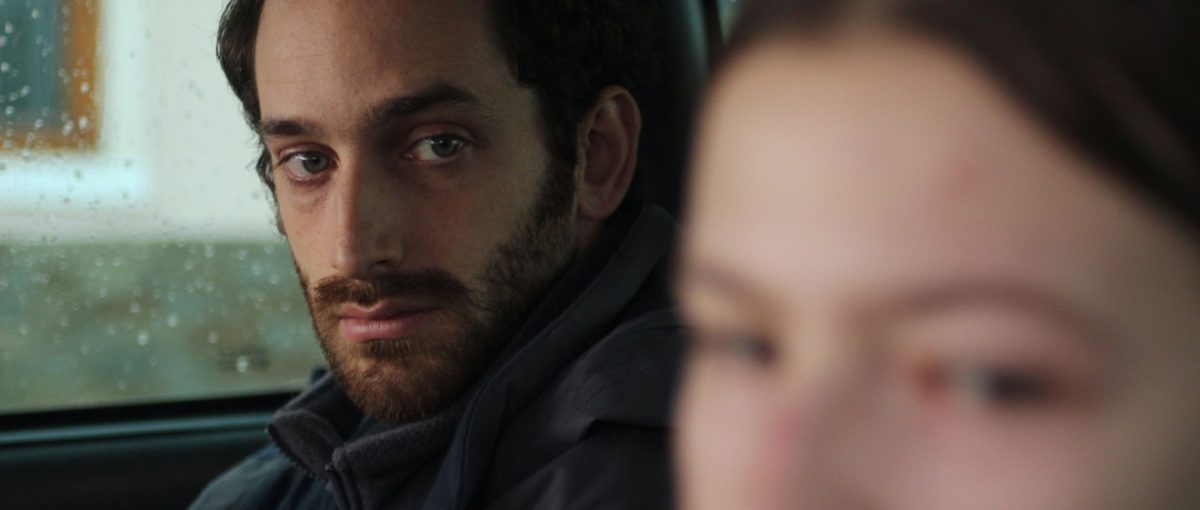From a group of young boys either diving, swimming or lankily getting out of a Romanian Olympic swimming pool, our eyes are guided towards a window from where their adult guardians are watching the events. The slowly decreasing distance between the camera and its subject invites the gaze of the viewer to wander and decide whom of these observers to observe. The symmetrical composition, the architectural lines and the presence of a standing male body at the very center of it invite us to choose a specific human point of focus, but an almost imperceptible move to the right reveals the actual protagonist of the story that will unfold over the next 93 minutes. This elegant misdirection of the audience’s gaze is how The Fixer (Adrian Sitaru, 2016) starts. Unfortunately, this also represents a moment of cinematographic sensitivity that is missing elsewhere.
With a timer in hand, our journalist protagonist Radu, played by Tudor Aaron Istodor, is monitoring the aquatic efforts of his girlfriend’s son. Throughout the film, Sitaru will return to this situation again and again, intercutting shots of the child and the adult, one slashing through the water in clear physical strain, the other calculating how to improve, how to get the best results with the available material. The cold perfectionism, intrinsic to Radu’s attitude, is even pointed out in the text, during a cruel argument with his young ward, but this analytical and vaguely opportunistic way of perceiving another human being isn’t exclusive to the particularities of an almost familial dynamic. If anything, his job takes a morally dubious talent to more uncomfortable extremes. Though, during the film, he is rarely seen doing the work of a proper journalist.
As the title indicates, he is a fixer. Having ignored an early request for a negligible 300 word piece, Radu spends most of the story arranging a series of interviews and acting as translator for a small French team to whom he has given a bombastic scoop. Two Romanian teenage girls, who had been arrested in Paris while prostituting themselves, are being expatriated to their home country, the same land where they had been kidnapped and sold. Since one of them had already been the subject of a filmed interview, Radu’s sights are solely focused on getting his French colleagues some camera time with Anca, the remaining deportee.
Before we get to see the youth in the flesh, rather than as the ghost of an undefined idea haunting the film, Sitaru takes the viewer to the interior of her mother’s house, where another interview is attempted. Only in this scene does the director’s somewhat uncertain position in the pantheon of New Romanian Cinema seem justified by the use of some mildly beguiling long shots, highlighting the scene’s tension, the real time of human gesture and the naturalistic acting of the cast. Even so, the technical virtuosity and masterful direction of actors he has shown in past works like the dramatically fraught Illegitimate (2016) are miles ahead of the almost televisual stylistic approach on evidence here.
Apart from the aforementioned individual scenes and images, The Fixer is a film of generic medium shots and close-ups, like those used to fragment dialogue heavy scenes when a carefully composed master shot would have sufficed. Istodor’s face is often the visual anchor of such compositions, specifically his vitreous eyes, staggeringly prodding in their searching looks but almost always devoid of perceivable empathy. The actor thus shows the rare ability of telegraphing to the audience the action of listening and internally assimilating newly acquired information, of looking through another person and find vulnerable openings into their being. Even when the screenplay asks for some incongruently precipitous transfigurations of the character’s moral self-awareness, the actor manages to salvage Radu from turning into an alienating cypher or a chaotic mess of script demanded contrivances.
On the opposite end of this film’s acting transparency spectrum, Diana Spatarescu plays Anca as an opaque entity. Her line delivery is often done in monochord, her expression simultaneously suggesting the shock of trauma and a deeply unexpressive sort of emptiness. The climatic centerpieces, an interview in the backseat of a car and the awkward negotiations that precede it, position this vessel of disconcerting emptiness as the emotional anchor tying the narrative’s several thematic forays. That said, the superficial explorations on the ethics of journalism and the cruelty of manipulating other people aren’t very well developed throughout and don’t converge in any sort of intellectually satisfying way by the film’s climax.
The Fixer is based on real events and deals with admittedly caustic issues of our world, but it never seems as if the people involved with it have any strong opinion about the material or the harsh realities it references. Devoid, in equal measure, of personality, ambition or ingenuity, this mediocre attempt at social realism doesn’t even have the mercy of adequately copying its national cinematic vanguard’s simpler aesthetic elements. Instead of a dramatic gut punch, The Fixer only offers its audience the soft, powerless insinuation of a muted whisper.
